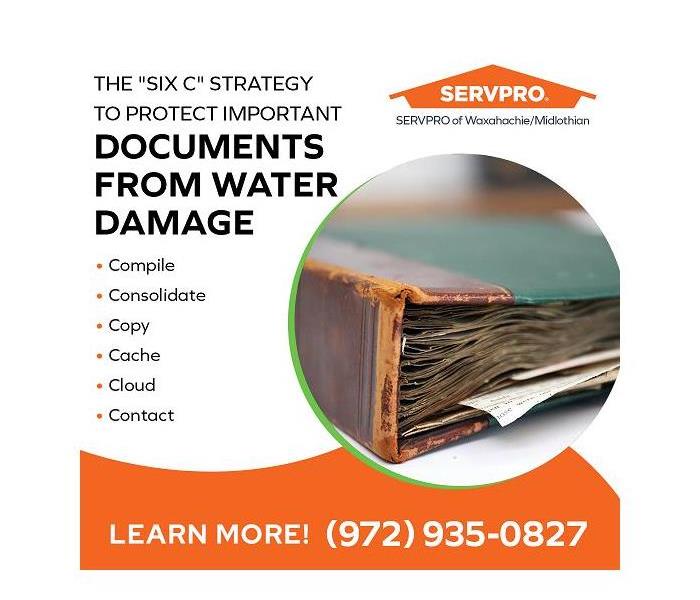Six Tips for Preventing Water Damage to Important Documents
3/7/2022 (Permalink)
Blog Summary: SERVPRO of Waxahachie/Midlothian offers strategies for preserving documents from water damage. In the event that water damage does occur, homeowners can turn to SERVPRO of Waxahachie/Midlothian for document restoration services.
SERVPRO of Waxahachie/Midlothian understands the importance of quickly beginning the water damage restoration process. That is why the team goes to extraordinary lengths to rapidly respond to a water damage disaster in an hour or less.
In the first few minutes of a serious water intrusion at a Midlothian, TX, home, water quickly spreads throughout the property, saturating everything in its path. Photographs, books, documents, and other paper items begin to exhibit signs of damage. After an hour of exposure to water and moisture, dyes and inks from cloth and paper goods spread and stain. In the first day or two, there is a musty smell. Within as little as 48 hours, mold and mildew start to grow on wet or moist items, especially documents and other paper products. Mold spores thrive on wood, cardboard, and paper. A musty odor appears. To prevent smudging, smearing, staining, deterioration, and mold growth, the homeowner must protect paper products from exposure to water and moisture. If exposed to water, photos, documents, and other paper goods must be carefully dried and cleaned with special equipment, techniques, and cleaning products.
Proactive Tips to Protect Important Documents from Water Damage
When a disaster strikes, the residents of the home often have little time to do more than safely escape. In those few available moments, taking the time to gather valuable possessions and important documents may mean the difference between life and death. However, proactive measures can be taken to protect the essential documents that will be crucial to repairing and rebuilding both lives and property in the wake of a disaster.
The “Six C” Strategy: Compile, Consolidate, Copy, Cache, Cloud, and Contact
- Compile
Compile an organized, itemized list of vital documents. Utilize technology to efficiently process the information. The sheer volume of documents may be overwhelming, but do not cut corners. Thoughtfully organize important documents into logical categories, such as:
- Personal identification
These documents identify members of the family and any other occupants in the home. They include legal IDs for work, school, and driving; hunting and fishing licenses; official birth certificates; marriage licenses; divorce certificates; military identification; proof of pet ownership; and passports.
- Financial and legal documents
This category can include a wide variety of documents, including credit and debit cards, mortgage and lease agreements, utility bills, vehicle loans, insurance policies, tax statements, etc.
- Health and medical documents
Health and medical information can vary widely from person to person, depending on the situation. The document compilation needs to include contact information for doctors, prescriptions, health insurance, and disabilities documentation.
- Consolidate
Consolidate all physical documents in a central, accessible location so that the documents can be easily and quickly accessed if a tornado, flood, fire, or other disaster occurs. One storage option is a filing cabinet, lockbox, or safe that can be easily transported or carried out of the structure. If possible, the container should be both waterproof and fireproof. Essential documents can also be stored offsite in a safe deposit box at a bank. Make sure the key or keys to these secure containers and the safe deposit box make their way out of the home before it is damaged or destroyed.
- Copy
Make backup paper copies of documents in case digital versions are lost, corrupted, damaged, or destroyed.
- Cache
Keep the collection, or cache, of copies in a safe, secure place away from the originals and master copies. An offsite location that is quickly and easily accessible by car is advisable.
- Cloud
Create electronic versions of each document. A secure online cloud storage service is recommended, but a CD or portable digital storage device will also suffice. Documents can be captured digitally with a scanner. Electronic files stored in the cloud are impervious to fire, water, and smoke damage. However, take necessary IT precautions and protect digital storage devices from damage or theft. Keep passwords secure. Consider two-factor authentication for the highest level of digital safety.
- Contact
Contact SERVPRO of Waxahachie/Midlothian for property damage cleanup and restoration services in the event of a natural disaster, flood, fire and smoke damage, or water intrusion from a burst pipe or sewage backup. SERVPRO offers state-of-the-art document cleaning and restoration. Their cutting-edge methods include document freeze-drying and gamma irradiation technology for sterilizing. The certified technicians are experienced in document drying, cleaning, and disinfecting water damaged documents. The team offers re-jacketing and deodorization when needed. Sensitive documents are kept under 24/7 surveillance managed by a HIPPA certified technician.
Locally owned and operated, SERVPRO of Waxahachie/Midlothian has served the area since 2000. The team of restoration experts specializes in residential, commercial, and large-scale disaster cleanup and restoration.
For more information about document drying services and water damage cleanup, contact SERVPRO of Waxahachie/Midlothian by calling (972) 935-0827 or by emailing acarey@SERVPRO10932.com



 24/7 Emergency Service
24/7 Emergency Service
